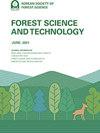Water stress changes on AMF colonization, stomatal conductance and photosynthesis of Dalbergia sissoo seedlings grown in entisol soil under nursery condition
IF 2.2
Q2 FORESTRY
引用次数: 4
Abstract
Abstract Water stress significantly impacts the plants’ physiological activity. They are influenced by the stomata and photosynthesis of the plant. The main objectives of the experiments are to determine the stomata and photosynthetic activity changes in the Dalbergia sissoo seedlings under the entisol soil in nursery conditions and the water stress conditions on AMF colonization. The plant growth characteristics and physiological activities in D. sissoo were assessed under three conditions: WW (well watering), FW (fractionated watering), and SW (stopped/no watering), with the results revealing that the FW condition has a higher mycorrhizal dependency of 24.53% than the WW condition, which is 24.37%. AMF root colonization was also higher in D. Sissoo, at 56% and 47% under FW and WW conditions. These findings highlight the significance of AMF, especially when plants are experiencing water stress. When FW was used instead of WW, the photosynthetic rate of D. sissoo and AMF + plants increased by 17.85%. AMF inoculation changed the plant’s physiological activities, resulting in a significantly higher photosynthesis rate and stomatal conductance. However, higher transpiration, intercellular CO2 concentration, and a lower leaf temperature regardless of WW or FW conditions indicate that AM positively affects physiological activities. The findings support the use of AMF in entisol soil to improve plant growth and biomass by alleviating adverse edaphic conditions.水分胁迫对黄檀幼苗AMF定植、气孔导度和光合作用的影响
水分胁迫显著影响植物的生理活性。它们受植物气孔和光合作用的影响。本试验的主要目的是研究苗圃条件下黄檀幼苗气孔和光合活性的变化以及水分胁迫条件对AMF定植的影响。在WW(井水)、FW(分水)和SW(停止/不浇水)3种条件下,测定了水韭植株的生长特性和生理活性,结果表明,水韭对菌根的依赖性为24.53%,高于WW(24.37%)。在FW和WW条件下,AMF的根定殖率分别为56%和47%。这些发现强调了AMF的重要性,特别是当植物经历水分胁迫时。用FW代替WW处理时,D. sissoo和AMF +植株的光合速率提高了17.85%。接种AMF改变了植株的生理活动,显著提高了植株的光合速率和气孔导度。然而,无论是WW还是FW条件下,较高的蒸腾、胞间CO2浓度和较低的叶温都表明AM对生理活动有积极影响。该研究结果支持在实体土壤中使用AMF通过减轻不利的土壤条件来改善植物生长和生物量。
本文章由计算机程序翻译,如有差异,请以英文原文为准。
求助全文
约1分钟内获得全文
求助全文

 求助内容:
求助内容: 应助结果提醒方式:
应助结果提醒方式:


